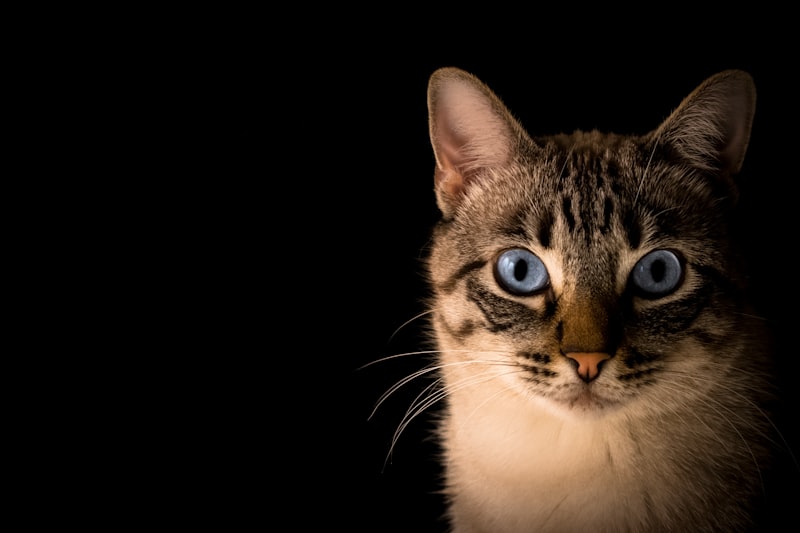Start by gathering your materials: sturdy wood for the base and posts, sisal rope for scratching surfaces, plush fabric for comfortable perches, and a variety of tools like a saw, drill, and hammer. Planning is key; sketch out your design to ensure stability and functionality. Consider incorporating multiple levels for climbing and resting, platforms for lounging, and scratching posts covered in sisal rope to save your furniture.
As you begin assembling, remember to secure each piece tightly to prevent wobbling. Wrap the posts with sisal rope tightly to create durable scratching surfaces that appeal to your cat’s natural instincts. Attach plush fabric or carpet securely to provide cozy spots for lounging and napping.
Throughout the process, engage your creativity—think of it as building a playground for your beloved pet. Ensure all materials are pet-safe and sturdy enough to support your cat’s weight and movements. After construction, introduce your cat to the new tree gradually, encouraging exploration with treats and toys.
Building a DIY cat tree isn’t just about functionality; it’s about creating a space where your cat feels safe, stimulated, and comfortable. Enjoy the satisfaction of watching your cat play and relax in a structure you’ve lovingly crafted—a testament to your dedication to their happiness and well-being.
Step-by-Step Guide: Building Your Own Cat Tree from Scratch
Have you ever wondered how to create the purrfect playground for your feline friend? Building a cat tree from scratch can be a rewarding and fun project that not only saves you money but also ensures you customize it to suit your cat’s preferences. Let’s dive into the step-by-step process of crafting a cat tree that will leave your furry companion feline fine!
-
Gather Your Materials: Start by collecting all the necessary materials such as wood boards, sisal rope, carpet scraps, and a sturdy base. These will form the foundation of your cat tree.
-
Design Your Tree: Sketch out a rough design or blueprint. Consider how tall you want the tree to be and what features you’d like to include, such as scratching posts, perches, and hideaways.
-
Cutting and Assembly: Begin by cutting the wood boards to size based on your design. Assemble the base first, ensuring it’s stable and can support the weight of your cat.
-
Wrap with Sisal Rope: Cats love to scratch, so wrap the scratching posts with sisal rope. This provides a durable and attractive scratching surface that will keep your furniture safe from sharp claws.

Add Perches and Platforms: Install platforms at different heights for your cat to climb and perch. Secure them firmly to the tree to ensure they can support your cat’s weight.
-
Cover with Carpet Scraps: Use carpet scraps to cover the platforms and perches. This gives your cat a comfortable place to lounge and nap.

Incorporate Toys and Accessories: Enhance your cat tree with toys, hanging ropes, or even a cozy hammock. These additions will keep your cat entertained and engaged.
-
Safety Check: Before letting your cat explore the new tree, conduct a safety check. Ensure all parts are securely fastened and there are no loose ends that could pose a hazard.
Building your own cat tree allows you to create a personalized space that your cat will love. It’s a project filled with creativity and satisfaction, knowing you’ve crafted something special for your beloved pet. Ready to embark on this DIY adventure? Gather your materials and let’s get started on building the ultimate cat paradise!
Creative DIY: Constructing a Custom Cat Tree for Your Feline Friend
Creating a custom cat tree for your beloved feline is not just a project; it’s a labor of love. Imagine transforming a few simple materials into a sprawling playground that your cat will adore. Building a DIY cat tree allows you to tailor every aspect to your pet’s preferences and personality, ensuring they have a safe and enjoyable space to climb, scratch, and nap.
To start, gather your materials: sturdy wooden boards, sisal rope for scratching posts, soft fabric for cozy perches, and a variety of tools like a saw, drill, and staple gun. The key is to choose materials that are both durable and safe for your cat to use regularly.
Begin by planning the structure. Think about how high you want the tree to be and where you’ll place it in your home. Cats love heights, so incorporating different levels and platforms will keep them engaged. Use the wooden boards to create a base and build upwards, securing each level firmly to ensure stability.
Next, add the scratching posts. Wrapping sisal rope around the wooden posts not only provides a satisfying scratching surface for your cat but also adds to the aesthetic appeal of the tree. Cats instinctively scratch to mark their territory and keep their claws healthy, so having designated scratching posts will deter them from furniture.
For the perches and hideouts, use soft fabric or carpet remnants. Cats enjoy cozy spots where they can curl up and observe their surroundings. Secure these materials firmly to the wooden structure, ensuring they can support your cat’s weight without wobbling.
As you assemble the tree, think about your cat’s habits. Do they prefer to climb, scratch, or nap in high places? Tailoring the design to their habits ensures they’ll use and love their new tree. Consider adding dangling toys or feathers to encourage play and exploration.
Building a custom cat tree is not just about creating a functional piece of furniture; it’s about enriching your cat’s environment and fostering their natural behaviors. By dedicating time and effort to this project, you’re creating a special space where your feline friend can feel safe, happy, and entertained.
Easy and Affordable: DIY Cat Tree Ideas That Won’t Break the Bank
Are you a cat lover looking to spoil your furry friend without breaking the bank? Creating a DIY cat tree can be a fun and rewarding project that your cat will love. Not only does it provide them with a place to play and relax, but it also adds a unique touch to your home decor. Let’s explore some easy and affordable DIY cat tree ideas that you can easily make at home.
One of the simplest DIY cat trees involves repurposing old wooden crates. Stack them on top of each other, secure them with screws, and voila! You have a multi-level cat tree that provides plenty of climbing and perching opportunities. You can further enhance it by wrapping sisal rope around the posts to give your cat something to scratch.
If you’re feeling more adventurous, try using PVC pipes and connectors to create a modular cat tree. Cut the pipes to different lengths and assemble them into various configurations using the connectors. This allows you to customize the tree based on your cat’s preferences and the space available in your home.
For a natural look, consider using real tree branches. Find sturdy branches of varying sizes, clean them thoroughly, and secure them together using wood glue and brackets. Add platforms at different heights for lounging spots, and wrap the branches with twine or sisal rope to create scratching surfaces.
Another budget-friendly option is to repurpose old furniture. An unused wooden ladder can easily be transformed into a cat tree by adding shelves or baskets at each step. You can also cover the ladder with carpet or fleece to create cozy lounging areas for your cat.
When designing your DIY cat tree, think about your cat’s preferences and habits. Cats love to climb, scratch, and perch in high places, so make sure to incorporate these elements into your design. By creating a personalized cat tree, you not only save money but also provide your furry friend with a special space they can call their own.
Get creative with materials you already have at home or can easily acquire. With a little imagination and effort, you can create a DIY cat tree that both you and your cat will adore.
This article aims to provide practical ideas while maintaining a conversational tone, engaging the reader with tips on creating a DIY cat tree that’s both economical and enjoyable.
Crafting Comfort: Build a Cat Tree That Your Kitty Will Love
Building a cat tree isn’t just about creating a structure; it’s about crafting comfort and joy for your beloved feline friend. Imagine a world where your cat leaps with excitement, perches on a custom-made tree designed specifically for their delight. This guide will take you through the steps to create a cat tree that your kitty will adore.
First things first: gather your materials. Think sturdy wooden platforms, natural sisal rope for scratching posts, and cozy faux fur for lounging areas. These materials not only ensure durability but also provide a comfortable and safe environment for your pet.
Now comes the fun part: designing the layout. Consider your cat’s personality and habits. Do they love to climb or prefer to lounge? Incorporate different levels for climbing, scratching posts at strategic points, and cozy perches for napping. Think of it as creating their own personal playground.
As you begin construction, keep your cat’s safety in mind. Secure all parts firmly, especially platforms and perches. Use non-toxic materials and avoid any sharp edges that could harm your pet. This tree should be a haven, not a hazard.
Enhance the tree with personal touches. Maybe a dangling toy or a small, hidden treat compartment. These additions make the tree even more enticing for your curious cat, encouraging exploration and play.
Once your masterpiece is complete, introduce it to your cat with enthusiasm. Place their favorite toys or treats on the tree to attract them. Use positive reinforcement to encourage exploration. Soon enough, they’ll be climbing, scratching, and lounging with pure contentment.
From Scraps to Snuggles: Transforming Household Items into a Cat Paradise
Ever wondered how to turn everyday household items into a haven for your beloved feline friend? Transforming your home into a cat paradise doesn’t have to break the bank. With a little creativity and some DIY spirit, you can create a space that your cat will adore.
Start by repurposing old furniture. That worn-out bookshelf? Convert it into a vertical playground by adding shelves at varying heights for climbing and lounging. Secure carpet pieces or sisal rope to the shelves for scratching satisfaction. Your cat will love having a perch to survey their kingdom from above.
Got cardboard boxes lying around? Don’t toss them—cats adore them! Cut holes in the sides to create cozy hideaways or connect multiple boxes to form a maze. Fill them with soft blankets or cushions for extra comfort. Cats are natural explorers, and a cardboard castle will keep them entertained for hours.
Next, repurpose fabric scraps into DIY toys. Tie fabric strips into knots or sew them into small pouches filled with catnip or crinkly material. These homemade toys are not only cost-effective but also safe and engaging for your furry friend.
For a touch of luxury, repurpose an old sweater or blanket into a plush cat bed. Cut and sew the fabric into a cozy nest, lined with a soft cushion or blanket inside. Place it in a sunny spot or near a window where your cat can bask in the sunlight while lounging in comfort.
By repurposing household items into a cat paradise, you’re not only saving money but also creating a space that reflects your love for your pet. Embrace your creativity, and watch as your cat enjoys their personalized playground made just for them.
Upcycling Fun: Turn Old Furniture into a Stylish Cat Tree
Ever looked at that old bookshelf gathering dust in your garage and wondered what to do with it? Imagine transforming it into something both practical and stylish. Upcycling, the art of giving new life to old items, has gained popularity for its creative and sustainable approach. One delightful project that combines creativity with functionality is turning old furniture into stylish cat trees.
Imagine your furry friend lounging on a custom-made cat tree, crafted from materials you already have. It not only saves you money but also reduces waste and adds a personalized touch to your home decor. By upcycling, you’re not just repurposing furniture; you’re creating something unique that reflects your style and care for the environment.
The process begins with selecting the right piece of furniture. Anything from an unused ladder to an old chest of drawers can be transformed. Assess the structure for stability and potential modifications. Remove unnecessary parts and sand down rough edges to ensure safety for your pet.
Next, unleash your creativity. Paint the furniture with pet-safe colors or patterns that complement your interior design. Add platforms at varying heights for climbing, cozy beds for resting, and scratching posts for sharpening claws. Incorporate toys or hanging elements to entertain your cat while adding aesthetic value to your creation.
Upcycling furniture into a cat tree isn’t just about functionality; it’s about creating a focal point in your home that sparks conversations and admiration. Each scratch mark or worn edge tells a story of transformation and love for your pet. It’s a testament to how small changes can make a big impact, both in your living space and in reducing your carbon footprint.
So, the next time you spot an old piece of furniture waiting to be discarded, consider the possibilities. With a touch of creativity and a commitment to sustainability, you can turn it into a stylish cat tree that enriches your home and delights your feline companion.
Frequently Asked Questions
How much time does it take to build a cat tree
Learn about the time required to build a cat tree, from assembly to completion.
What materials do I need to build a cat tree
Discover the essential materials needed to construct a cat tree efficiently. This concise guide outlines the key supplies required, ensuring you can create a sturdy and enjoyable space for your feline friend.
Can I customize the design of my cat tree
Learn how to customize your cat tree design with our concise guide. Discover tips on adding personal touches, adjusting dimensions, and choosing materials to create a unique and tailored cat tree for your feline friend.
Are there any safety considerations when building a cat tree
Discover essential safety considerations when constructing a cat tree to ensure your pet’s well-being and enjoyment.
How do I maintain and clean a homemade cat tree
Learn how to effectively maintain and clean your homemade cat tree with our concise guide. Discover essential tips and methods to ensure your cat’s tree stays clean, safe, and durable.



